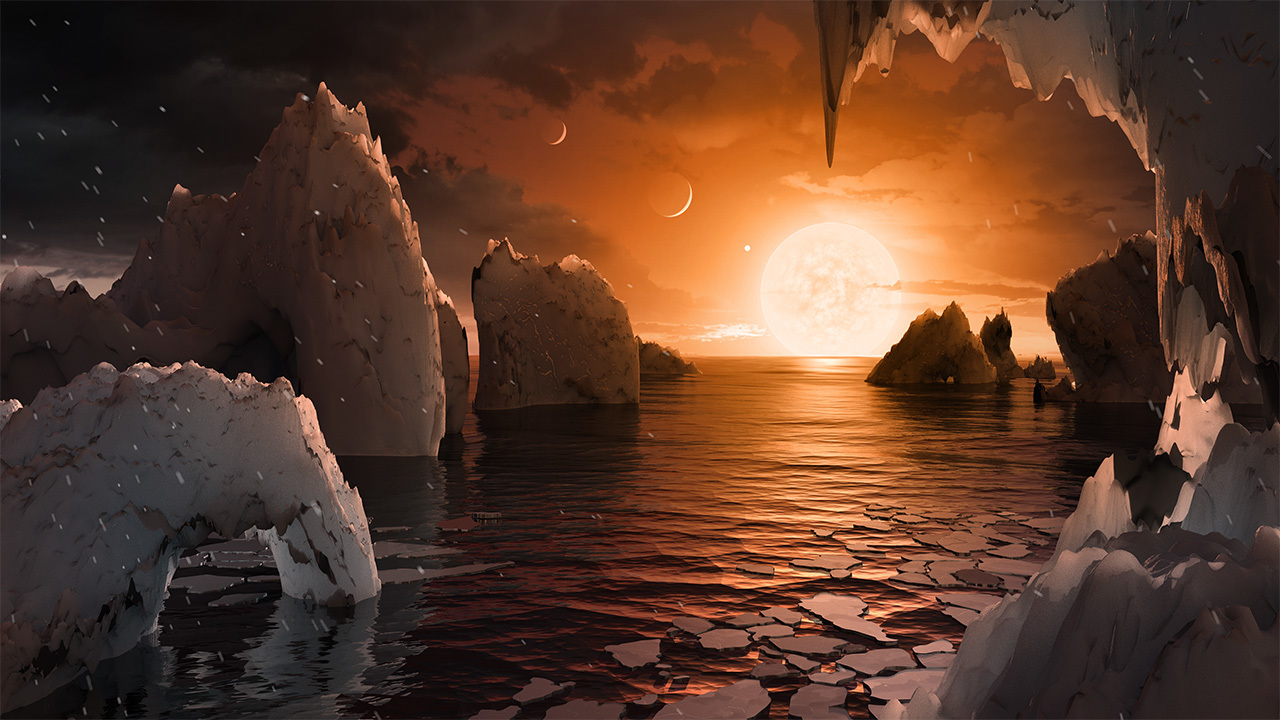How James Webb Space Telescope's studies of TRAPPIST-1 flares could aid the search for alien life
The powerful space telescope scrutinized four flares from the volatile red dwarf star, around which at least seven roughly Earth-size planets orbit.

NASA's James Webb Space Telescope (JWST) has taken a closer look at a volatile star at the heart of a system of seven potentially Earth-like worlds, some of which might be able to support life as we know it.
The powerful space telescope studied four flares erupting from the star TRAPPIST-1, a cool red dwarf that's located about 41 light-years from Earth in the constellation Leo. Researchers decrypted the flares' radiation from the star's regular light, something that could aid the hunt for habitable conditions in this extraordinary system.
"Because of JWST, it is the first time in history that we've been able to look for planets around other stars that have the sorts of secondary atmospheres you could find around, say, Earth, Venus, or Mars," research lead author Ward Howard, a NASA Sagan Fellow at the University of Colorado, Boulder, said in a statement. "If we want to learn more about exoplanets, it's really important to understand their stars."
Related: James Webb Space Telescope finds no atmosphere on Earth-like TRAPPIST-1 exoplanet
Red dwarfs like the Jupiter-sized TRAPPIST-1, which has a mass around 9% that of the sun, are the most common stars in the Milky Way and, despite their small stature, are also the most active. TRAPPIST-1 emits powerful blasts of energy as flares several times a day. Our own sun, by contrast, erupts with similar outbursts just once a month or so.
The violent activity of red dwarfs makes studying the atmospheres of their exoplanets a challenge. Astronomers study alien atmospheres by observing light as it passes through them, and chaotic emissions of stellar radiation complicate this process.
Howard and his colleagues addressed this challenge by observing flares emerging from TRAPPIST-1 over a period of roughly 27 hours. They then separated these bursts of light from the regular light coming from the star, filtering out around 80% of the flare-based radiation.
Breaking space news, the latest updates on rocket launches, skywatching events and more!
"If you don't account for flares, you could detect molecules in the atmosphere that aren't really there or get the amount of material in the atmosphere wrong," Howard explained.
Additionally, not only was the team able to observe a stellar flare in certain wavelengths of infrared light for the first time with JWST, but they also captured the evolution of those four flares in detail, watching over several hours as they grew in brightness before peaking and becoming dim again.
This method could be key for obtaining clearer images of planetary atmospheres and will likely be applied to the TRAPPIST-1 system in particular, the researchers said.
Related: The search for alien life
What makes TRAPPIST-1 a prime target for scientists?
TRAPPIST-1 has been a tantalizing target for astronomers since three planets were first discovered around the red dwarf star in 2016. The fascination with the system in the astronomical community intensified with the discovery of a further four planets around the red dwarf star, itself discovered in 1999.
Not only do these planets seem to be rocky like Earth, but three of them exist in the habitable zone of TRAPPIST-1, the region in which it is neither too hot nor cold to allow water to exist as a liquid on a world's surface — a vital condition for life as we know it.
JWST is already starting to investigate the atmospheres of the TRAPPIST-1 worlds. A recent study of one of those planets, TRAPPIST-1b, revealed that it seems to lack an atmosphere. This new breakthrough should allow astronomers to get an even clearer picture of the conditions around the planets of this fascinating system.
"With TRAPPIST-1, we have a really great opportunity to see what an Earth-sized planet around a red dwarf would look like," Howard said. "There are only a handful of stellar systems where we have the opportunity to look for these sorts of atmospheres. Each one of these planets is truly precious."
The team's research has been accepted for publication in The Astrophysical Journal, and a preprint version is posted on the paper repository arXiv.

Robert Lea is a science journalist in the U.K. whose articles have been published in Physics World, New Scientist, Astronomy Magazine, All About Space, Newsweek and ZME Science. He also writes about science communication for Elsevier and the European Journal of Physics. Rob holds a bachelor of science degree in physics and astronomy from the U.K.’s Open University. Follow him on Twitter @sciencef1rst.

